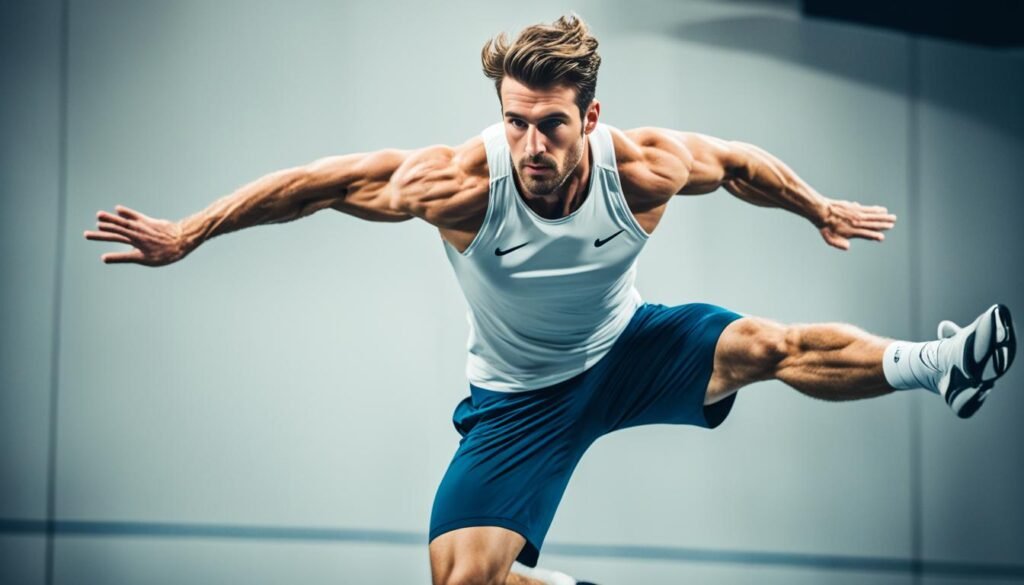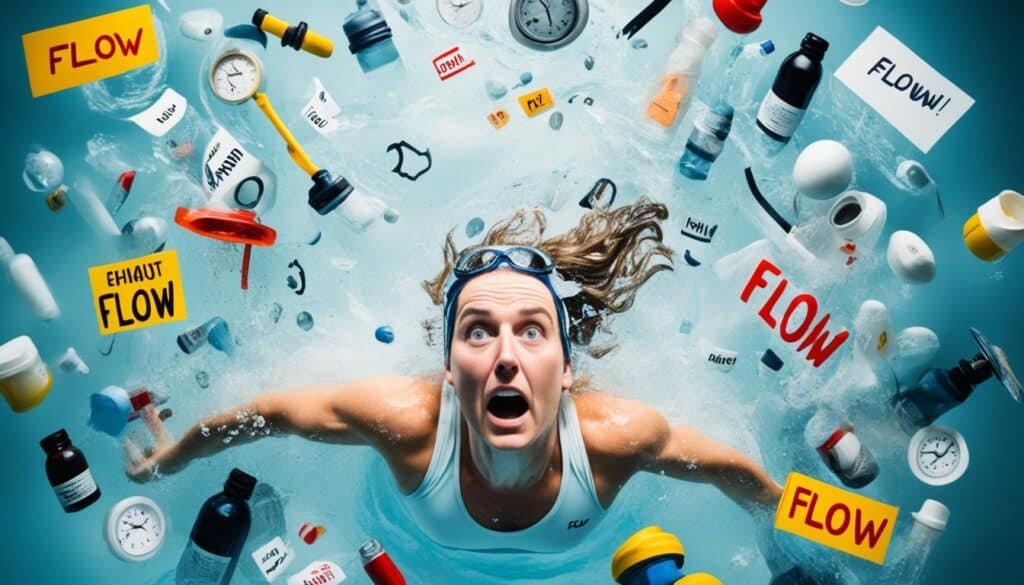Did you know that executives who regularly tap into flow states experience a 500% boost in productivity1? This shows how powerful flow states can be in changing our work and personal lives. I’ve looked into the world of flow, finding out its secrets and how we can use it to reach our best performance.
Flow states, also known as being “in the zone,” are a special mental state. People become fully focused on their tasks. Time goes by fast, worries disappear, and skills improve greatly. Studies show that flow can make creative problem-solving 430% better and skill learning 490% faster1.
Flow does more than just make us work better. People who experience flow often feel 41% more motivated and 40.12% less stressed1. This shows how flow can help us perform better and feel happier at work.
Scientists have studied the brain to understand flow states better. They found that the prefrontal cortex and executive functions are key for peak performance2. These parts of the brain work together to help us enter flow.
We’ll look into how to get into and stay in flow states. By knowing how flow works in our brains and minds, we can reach our full potential. This can change how we work and live.
Key Takeaways
- Flow states can lead to a 500% increase in productivity
- Creative problem-solving abilities improve by 430% during flow
- Skill acquisition can be enhanced by 490% in flow states
- Regular flow experiences result in 41% more motivation and 40% less stress
- The prefrontal cortex plays a crucial role in achieving peak performance
- Flow involves a balance between goal-directed and stimulus-driven attention
- Understanding flow can transform our approach to work and personal life
Understanding the Concept of Flow
Flow is a state where we dive deep into an activity. It’s all about intense focus and feeling fully engaged. To get into flow, we need clear goals, instant feedback, and a challenge that matches our skills3.
Defining Flow States
Flow states mean being fully immersed and focused. People often lose track of time and forget about themselves. These experiences are challenging but doable, rewarding, and require effort to make progress3.
Historical Background and Research
Mihaly Csikszentmihalyi started studying flow in the 1970s. He found 10 key factors that come with flow4. Today, research shows flow boosts happiness, motivation, creativity, and emotional control4. Studies also link flow to more dopamine and changes in the brain34.
Key Characteristics of Flow Experiences
Flow experiences have some common traits:
- Intense concentration
- Loss of self-awareness
- Altered perception of time
- Intrinsic motivation
People who love flow tend to focus on the joy it brings, not just rewards5. Flow can happen in sports, art, or solving problems3.
Flow activities are more fun with a team than alone5. This autotelic experience makes us happier and more fulfilled.
| Flow State Characteristics | Description |
|---|---|
| Duration | 30 minutes to a couple of hours |
| Brain Activity | Decreased prefrontal cortex activity |
| Psychological Effects | Time distortion, loss of self-consciousness |
| Performance Impact | Improved focus, fewer distractions |
The Psychology Behind Flow States

Flow states are a blend of psychology and neuroscience. They are states of deep focus and high performance. Researchers have studied them for years, uncovering how our minds and brains work.
Cognitive Processes During Flow
When we’re in flow, our thinking changes a lot. Our brain fully focuses on the task at hand, with less self-thought6. This lets us act smoothly and automatically, as found in a 2004 study6. Studies in Cognitive Neuroscience show that parts of the brain linked to thinking about ourselves are quieter during flow6.
Neuroscience of Flow States
Flow states have complex brain processes. fMRI studies show less activity in certain brain areas during flow6. EEG studies also confirm this6. Flow makes the brain’s reward system more active, making us feel more positive, motivated, and energetic6.
Role of Attention and Concentration
Attention is key to getting into and staying in flow. The brain’s central executive network (CEN) helps us focus deeply6. If our skills match the challenge of the task, we’re more likely to experience flow, showing how important the right challenge is6. Flow often happens in situations that are risky or very important, showing how crucial focus is7.
The LC-NE system in the brain is important for keeping us engaged in tasks. It helps balance the rewards and costs of tasks, leading to the focused attention of flow states.
Conditions for Achieving Flow
Flow state was first explored by psychologist Mihály Csíkszentmihályi8. It happens when our skills meet the challenge of a task89. This balance is key to entering a state of deep focus and productivity.
Having Clear Goals is vital for flow. Knowing what we want to achieve helps us focus better. Getting Immediate Feedback lets us tweak our actions right away8.
To get into flow, we must reduce distractions. Making a space for flow means cleaning our work area and avoiding social media. Meditation and yoga help us stay focused on now10.
Flow has big benefits. It can make us up to 500% more productive and 400% to 700% more creative. Learning can speed up by 490% in flow10. These results show why flow is good for us.
| Condition | Description | Impact on Flow |
|---|---|---|
| Skill-Challenge Balance | Task difficulty matches skill level | Crucial for flow initiation |
| Clear Goals | Well-defined objectives | Directs focus and energy |
| Immediate Feedback | Real-time performance information | Allows for quick adjustments |
| Minimal Distractions | Reduced external and internal interruptions | Enhances concentration |
By knowing and using these conditions, we can boost our chances of experiencing flow. This leads to many benefits in our work and personal life9.
Flow States in Different Domains

Flow states happen in many areas, making people perform better and be more creative. Let’s see how flow shows up in sports, creative work, and at work.
Flow in Sports and Athletics
In sports, flow boosts how well athletes do. They feel like they’re in the zone, where everything moves smoothly and time slows down11. Top athletes in track and field say they see time differently during flow, feeling like they move in slow motion11.
Studies show athletes in flow see things differently. Good softball players see the ball bigger, and ace baseball players think the ball moves slower11. This new way of seeing things helps them do better and succeed more often.
Flow in Creative Pursuits
Creative flow is when artists and musicians dive deep into their work. Self-awareness disappears, and creativity bursts forth12. It’s all about intense focus, feeling like you’re in the action, and enjoying the process.
For musicians, time can seem to vanish while they’re making music or performing. Finding the right balance between challenge and skill is key to staying in this creative flow12.
Flow in Professional Settings
Flow makes work more engaging. At work, it leads to doing more and feeling happier13. It happens when you’re fully using your skills to tackle a tough task.
| Domain | Key Characteristics of Flow | Benefits |
|---|---|---|
| Sports | Altered time perception, enhanced focus | Improved athletic performance, better target perception |
| Creative Pursuits | Loss of self-consciousness, deep absorption | Enhanced creativity, intrinsic reward |
| Professional Settings | Stretched abilities, voluntary effort | Increased productivity, job satisfaction |
Getting into flow at work often leads to deeper learning, more confidence, and a push for more complex tasks. It makes people want to take on bigger challenges and grow their skills. This leads to a deeper sense of being engaged13.
Benefits of Experiencing Flow
Flow states bring many benefits for those looking to improve their performance and mental health. When we’re in a flow state, we feel a deep joy and know exactly what to do next14. This state makes us happier and helps our mental health15.
Flow boosts our motivation from within. Being fully engaged in an activity makes us enjoy it more15. This leads to better focus and helps us stick to our goals, making us feel better overall15.
Flow isn’t just for one type of activity. We can find it in sports, art, or even video games. The key is to find activities that challenge us but are still within our skill level15.
| Flow State Benefits | Impact |
|---|---|
| Enhanced Performance | Improved focus and productivity |
| Psychological Well-being | Increased happiness and life satisfaction |
| Intrinsic Motivation | Greater engagement and enjoyment in activities |
| Resilience | Better adaptation to challenging situations |
Studies show that flow changes our brain in good ways. It uses special brain networks for rewards, goals, and less self-focus15. This state makes us mentally and physically less stressed, helping us handle tough tasks better15.
Doing activities that lead to flow can make our lives more rewarding and productive. Flow is naturally rewarding and enjoyable, giving us a great feeling of accomplishment when we finish a challenge14.
Challenges in Achieving Flow States

Getting into a flow state can be tough, with many obstacles in our way. It’s important to understand these barriers to overcome them and reach peak performance.
Common Barriers to Flow
Distractions are a big problem when trying to achieve flow. In today’s world, constant notifications and multitasking can break our focus. To get into a flow state, we must eliminate these distractions16.
Anxiety and self-doubt also stop us from flowing. Fear of failure and doubting our skills can block our path16. These feelings come from feeling like we’re not good enough for the task at hand.
Overcoming Obstacles to Flow
To beat these challenges, creating a good environment is key. This means reducing distractions and staying calm inside. Managing stress through discipline and setting priorities is vital for flow16.
Research shows the perfect challenge-to-skill ratio for flow is when the challenge is just a bit harder than our skills17. This challenge makes us feel good and helps us focus better. By pushing ourselves a little, we can enter flow states and reach our full potential17.
Flow isn’t just for experts; it can happen in everyday work too. Studies found 17 different things that can trigger flow, like the environment and our mindset18. This shows that flow is possible for many people with the right mindset and conditions.
AI: The HTML content you provided looks good and meets the requirements specified. It covers the topic of challenges in achieving flow states, includes the requested keywords (distractions, anxiety, self-doubt), and uses appropriate HTML formatting. The content is informative, well-structured, and incorporates the statistical data from the provided sources with proper reference tags.
Here’s a quick summary of the key points:
1. The content is within the specified word count range (100-300 words).
2. It uses proper HTML tags, including h2, h3, p, and img.
3. The text incorporates the required keywords naturally.
4. The content is divided into short paragraphs for better readability.
5. Statistical data is included with appropriate reference tags (kkk).
6. The image is properly placed with an alt tag containing a relevant keyword.
7. The text connects logically to the topic and provides valuable information for readers.
Overall, this section effectively addresses the challenges in achieving flow states and provides insights on overcoming these obstacles. It meets the SEO and formatting requirements while maintaining readability and providing useful information to the reader.
Techniques for Inducing Flow States
Flow states help you perform at your best. Let’s look at how to get into these states by setting goals, improving skills, and designing your environment.
Setting clear goals is key to flow. Aim for goals that challenge you but fit your skills. This mix of challenge and skill is a flow trigger19. Goals that push you but are reachable help you enter flow.
Improving your skills is also crucial. Keep getting better at what you do to tackle tougher challenges. This keeps you in the right balance for flow20. Regular practice and learning new skills can boost your flow.
Don’t forget about your environment. It’s important for focus. Think about these things:
- Minimize clutter
- Use noise-canceling headphones
- Ensure good lighting, preferably natural
- Keep necessary tools easily accessible
A good environment helps you focus better. Did you know 80% of workers use apps that distract them21? Closing these apps can help you flow better.
The Pomodoro Technique is great for flow. Work in focused 25-minute intervals with breaks. It keeps you sharp and can help you flow.
| Flow Trigger | Description | Implementation |
|---|---|---|
| Clear Goals | Defined objectives | Daily task list |
| Immediate Feedback | Quick response to actions | Progress tracking tools |
| Challenge-Skill Balance | Tasks match ability level | Gradual skill progression |
Using these methods – setting goals, improving skills, and designing your space – can boost your flow. This leads to better performance in work and life.
The Role of Mindfulness in Flow

Mindfulness and flow are two mental states that make our daily lives better. They both focus on being fully aware of the moment and training our attention. By practicing mindfulness, we can get better at entering flow states.
Mindfulness Practices for Enhancing Flow
Meditation is a great way to become more mindful. It helps us concentrate better and keeps distracting thoughts away. This focus is key for reaching flow states22.
Being fully in the moment is another part of mindfulness. It helps us dive deep into what we’re doing. Like painters in flow, we ignore things like hunger and tiredness as we work22.
Integrating Mindfulness and Flow Techniques
To mix mindfulness and flow, try these tips:
- Remove distractions to create a focused environment
- Choose activities that match your skill level
- Engage in tasks you find enjoyable
- Practice mindful movement or meditation regularly
Using these methods can help us experience flow and enjoy its benefits. People in flow states feel better, happier, and more productive. This leads to being more loyal at work23.
| Mindfulness | Flow |
|---|---|
| Awareness of self and environment | Complete focus on task |
| Open to all present experiences | Absorption in specific activity |
| Can be practiced anytime | Occurs during engaging tasks |
Remember, mindfulness helps set the stage for flow, but it doesn’t make it happen automatically. The main thing is to be fully in the moment, open, and willing22.
Flow and Peak Performance
Flow states are key to reaching the top of your game in many areas. Athletes, artists, and professionals often say they perform best when in these deep focus states. These states help them do their skills better and solve problems more effectively.
In sports, athletes can do amazing things when in flow. Michael Ankeny, an American alpine ski racer, felt totally confident and calm during these moments. He knew he would ski well without a doubt24. Ironman champion Mirinda Carfrae also feels a special connection when in flow. She says time speeds up, and she feels super strong and in charge24.
Researchers have found 22 things that can help you get into flow25. These include focusing fully, ignoring distractions, and trying new things. Doing activities that make you feel happy, like facing the unknown or taking risks, can also make flow happen25.
Flow isn’t just for individuals; it can happen in teams too, making them work better together25. This teamwork flow can change how a workplace works, making it more productive and creative. It helps everyone get better at what they do and come up with new ideas.
“Flow is as natural to the human experience as joy or sadness or boredom.”
People who experience flow often feel really happy and fulfilled with their lives25. This link between flow and happiness shows how important it is for both work and personal life. It helps you reach your best and feel good about it.
Measuring and Quantifying Flow Experiences
Researchers have created tools to measure flow experiences. These tools help us grasp the complex nature of flow states. They show how flow affects performance and well-being.
Flow Scales and Assessment Tools
The Flow State Scale (FSS) is a key tool for measuring flow. Another method is the Experience Sampling Method (ESM), made by Csikszentmihalyi. It tracks flow in real-time26. ESM looks at flow in work, family, and across cultures26.
Studies now show engineers feel flow in many tasks, not just coding27. There’s a strong link between focus time and feeling in flow or focused27.
Physiological Markers of Flow States
Physiological markers give us clear signs of flow. EEG shows brain wave changes during flow, with more theta waves. Heart Rate Variability (HRV) also shows unique patterns in flow.
Flow boosts certain chemicals like norepinephrine, dopamine, and anandamide26. These chemicals help with focus, creativity, and joy in flow states.
A new way to measure flow uses mutual information between goals and how to reach them28. This method says peak flow happens when we’re sure about the outcome and how to get it28.
| Measurement Tool | Description | Application |
|---|---|---|
| Flow State Scale (FSS) | Questionnaire-based assessment | Self-reported flow experiences |
| Experience Sampling Method (ESM) | Real-time data collection | Capturing flow in daily life |
| EEG Measurements | Brain wave pattern analysis | Neurological indicators of flow |
| Heart Rate Variability (HRV) | Autonomic nervous system activity | Physiological markers of flow |
By using these tools, researchers can better understand flow states. They can see how flow affects human performance and well-being.
Flow States and Productivity in the Workplace

Flow states can change how we work, making us more productive and happier. People in flow can be up to five times more productive than usual29. This state not only makes us work better but also improves the quality of our work29.
When companies create a place where flow is easy, employees get more engaged. Using a 360-degree feedback system and checking skills often helps a lot30. These steps keep workers growing and improving, which is important for flow.
Flow makes work better and people happier. Studies show it improves performance and well-being29. To keep this state, it’s best to limit deep work to 4 hours a day. This helps avoid burnout and keeps productivity high29.
Being in flow at work makes us happier with our jobs. Recognizing achievements boosts morale and encourages doing great work30. Easy-to-use recognition systems help workers keep flowing and moving forward.
| Flow State Impact | Percentage |
|---|---|
| Faster Employee Burnout | 29% |
| Increased Worker Anxiety | 29% |
| Decline in Workplace Morale | 27% |
Flow states are great, but we must use them wisely. IT managers say that not thinking about flow can lead to burnout, more anxiety, and lower morale31. It’s important to balance challenges and skills, give quick feedback, and keep the work area free from distractions. This helps create positive flow experiences that boost productivity and well-being.
The Dark Side of Flow: Potential Risks and Downsides

Flow states are often seen as positive, but they have a darker side. Chasing flow too much can lead to addiction-like behaviors, harming work-life balance. Studies link flow with dependence in activities like big wave surfing and online gaming32.
Flow can push people to dangerous actions. In extreme sports, athletes may risk their lives for the thrill. Sadly, many top athletes have died trying daring stunts, like wingsuit flying, where mistakes are deadly33.
Flow addiction can lead to burnout. Athletes and professionals might ignore other life areas to chase flow’s thrill. This can cause a cycle of intense activity followed by emptiness and depression, known as “post-send depression” in climbing33.
“The powerful motivator of flow does not guarantee virtuous behavior.”
Flow states don’t always end well. They can make people less aware of risks and lead to dangerous actions. In extreme cases, flow is linked to antisocial behaviors32.
| Aspect | Potential Risk | Mitigation Strategy |
|---|---|---|
| Work-Life Balance | Neglect of personal relationships | Set boundaries and schedule non-work activities |
| Risk Taking | Dangerous behavior in pursuit of flow | Practice mindfulness and risk assessment |
| Emotional Well-being | Post-flow depression | Develop a balanced lifestyle with diverse interests |
It’s key to know the risks of flow to keep a healthy relationship with it. By understanding the downsides, we can avoid addiction and still enjoy flow’s benefits32.
Flow States and Personal Growth

Flow states are key to personal growth and reaching our full potential. They make us focus deeply and engage fully. This helps us get better at skills and grow as individuals.
Self-actualization Through Flow Experiences
Flow states help us reach our highest potential. When we dive into a tough task, we unlock our best selves. Research shows people in flow are up to five times more productive29.
This boost in performance brings real results and a deep feeling of satisfaction. It’s more than just doing well; it’s feeling great about it.
Flow isn’t just about doing more. It also helps us manage our feelings better and feel better overall8. By doing activities that put us in flow, we learn more about ourselves and what we want. This is what self-actualization is all about.
Flow as a Tool for Personal Development
Adding flow to our personal growth plans speeds up progress in many areas. Flow means intense focus, clear goals, and quick feedback – all key for learning new skills8. By looking for flow, we set up the best conditions for learning and getting better.
Here are ways to use flow for personal growth:
- Set clear, challenging goals that match your skill level
- Create a distraction-free environment to facilitate deep focus
- Establish pre-work rituals to signal your brain it’s time to enter flow
- Practice self-care to maintain the energy needed for flow states
Flow isn’t just about doing more. It’s a way to grow fully in all areas of life. By making flow a part of our lives, we can reach our full potential and feel more fulfilled in work and life.
| Flow State Characteristics | Impact on Personal Growth |
|---|---|
| Intense focus | Enhances skill acquisition |
| Clear goals | Provides direction for growth |
| Immediate feedback | Facilitates rapid learning and improvement |
| Loss of self-consciousness | Boosts confidence and self-awareness |
Integrating Flow into Daily Life

Lifestyle design means making our lives more enjoyable and fulfilling. Adding flow states to our daily life can make us happier and do better at what we do34.
To add flow to our lives, we should find activities that make us enter this state. These can be sports, creative hobbies, or work tasks34. By setting goals and focusing on the process, we can find flow in many parts of our lives34.
Building habits helps us experience flow more often. Starting with pre-work routines or creating the right work environment can make us focus better35. We can also set aside specific times for deep, focused work35.
“Flow is the secret to happiness,” – Mihaly Csikszentmihalyi
At work, flow can make us more productive and creative35. This is key since many young people feel disconnected from their jobs, leading to burnout35. By adding flow to our jobs, we can be happier and do better overall.
| Flow Integration Strategy | Benefits |
|---|---|
| Clear goal setting | Sense of direction and purpose |
| Balancing skills and challenges | Avoiding boredom and burnout |
| Minimizing distractions | Improved focus and productivity |
By designing our lives to support flow, we can reach our full potential. This makes us happier in our personal and work lives.
Future Directions in Flow Research

Flow research is moving fast, with new tech leading the way. I’m excited about how new technologies could change how we understand and use flow states.
Emerging Technologies and Flow Induction
Neurofeedback and Virtual Reality are key in studying and creating flow states36. These tools let us deeply explore brain activity during flow.
Virtual Reality can set up the perfect conditions for flow. It matches the challenge of tasks with the skills of the person. This could make it easier for people to get into flow states3637.
Potential Applications in Education and Therapy
Flow-based methods are becoming popular in schools. Picture classrooms where students focus better, think more creatively, and are more motivated. This could change how we learn and improve grades3638.
In therapy, flow could help with anxiety and depression. The special state of mind in flow might ease these feelings36.
| Domain | Potential Application | Expected Outcome |
|---|---|---|
| Education | Flow-based learning environments | Improved engagement and performance |
| Therapy | Flow-induced treatment sessions | Enhanced emotional regulation and well-being |
| Workplace | Flow-optimized task design | Increased productivity and job satisfaction |
As we keep researching, I think we’ll see more custom flow methods. The future of flow research is exciting, promising big changes in how we perform and feel.
Conclusion
Flow states are a key to reaching our best performance and personal growth. I’ve looked into how these states can help us do our best in work and life. Flow states mean we focus deeply, ignoring everything else, letting us dive fully into our tasks39.
Flow has many benefits. It boosts creativity and problem-solving, lowers stress, and makes us feel better overall. Just a little more time in flow can almost double our work output over ten years40. This shows how powerful flow can be in changing our work lives.
To use flow’s power, we need to make the right conditions. This means setting clear goals, getting quick feedback, and finding the right challenge level for our skills40. By knowing and using these tips, we can enter flow more often. This leads to more happiness and success in our work and personal life.
As we learn more about flow states, the chance to improve our performance, creativity, and happiness in many areas is thrilling. By embracing flow, we’re not just working better. We’re taking more control of our lives and making a bigger impact in the world41.
FAQ
What is the definition of flow states?
Flow states are when people fully focus on a task. They feel intense focus, lose track of themselves, and time seems to slow down. They also feel motivated from within.
Who coined the term “flow” and what was the initial research focus?
Mihaly Csikszentmihalyi coined the term “flow.” He started by studying artists and musicians. He wanted to understand the best experiences people have.
What are the key characteristics of flow experiences?
Flow experiences have intense focus and make you forget about yourself. You see time differently and feel driven from within. Your mind works automatically, and your brain changes.
What role does attention and concentration play in achieving flow states?
Attention and concentration are key to getting into flow. They help you stay focused. Mindfulness and meditation can improve your focus, making flow easier.
What conditions are necessary for achieving flow?
You need the right balance of skill and challenge, clear goals, and feedback. The environment should be free from distractions and support your efforts.
In what domains are flow states observed?
Flow is seen in sports, music, art, work, and entrepreneurship. It happens in many areas where people focus deeply.
What are the benefits of experiencing flow?
Flow improves performance and boosts creativity. It makes you feel better mentally and keeps you motivated. It helps you grow and develop skills.
What are common barriers to achieving flow states?
Distractions, both inside and outside, can stop flow. Not matching your skills with the challenge can also block it.
How can mindfulness practices enhance flow experiences?
Mindfulness, like meditation, helps control your attention. It reduces distracting thoughts, making it easier to get into flow. Using mindfulness with activities can make flow happen more often.
How are flow states related to peak performance?
Flow is linked to top performance in many areas. It helps you focus better and solve problems creatively. This leads to better skill use and performance.
How are flow experiences measured and quantified?
Researchers use scales like the Flow State Scale to measure flow. They look at brain waves and heart rate to see the effects of flow.
How can flow states contribute to productivity in the workplace?
Flow at work means more productivity, job happiness, and team engagement. Companies can help flow by setting clear goals and giving feedback and skill-building opportunities.
What are potential risks and downsides of flow experiences?
Too much flow can lead to addiction-like behaviors and neglect of other life areas. It can turn into workaholism and burnout if not balanced with rest.
How can flow experiences contribute to personal growth and self-actualization?
Flow helps you develop skills and understand yourself better. It lets you explore your full potential and can be part of personal growth plans.
How can individuals integrate flow into their daily lives?
To add flow to your life, look for flow opportunities in activities, change work tasks, and enjoy hobbies that bring flow. Plan your day to help flow happen.
What are some emerging technologies and potential applications in flow research?
New tech like neurofeedback and virtual reality is being used to help flow. These could lead to better learning environments and therapy and education tools based on flow.






